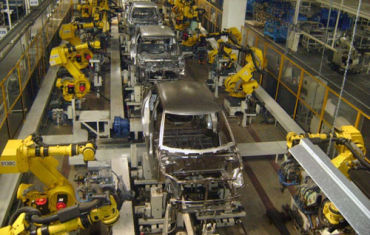Photographs: Reuters T N Ninan
The finance ministry likes to talk of the 'new normal' when it comes to inflation -- code for saying that everyone should get used to a higher rate of price increases.
The question is whether the country should also adjust its sights when it comes to growth, to a 'new normal'.
When considering the economy's potential for rapid growth, most people's mind-sets are influenced by the fact that India did better than 9 per cent in each of the three years of 2005-08.
That might explain the Planning Commission's decision to target 9-9.5 per cent average annual growth for the next five years (2012-17). Indeed, the prime minister and others have talked of even 10 per cent growth.
. . .
Is this the new normal rate of growth for India?
Photographs: Reuters
But 2005-08 may not be a good benchmark; they were exceptional years when the world economy as a whole was on steroids. Almost every country you can name outperformed in that period. In the subsequent three years, India has averaged only 7.8 per cent.
To some extent this was because of global turmoil. However, the Reserve Bank has now forecast no more than 8 per cent for this year. If that proves correct, this will be the fourth successive year of sub-9 per cent growth.
Perhaps the 'new normal' rate of growth is not 9 per cent plus, but only 8.5 per cent, give or take a bit. As it happens, the average annual growth actually achieved over the past eight years is 8.5 per cent.
. . .
Is this the new normal rate of growth for India?
Photographs: Reuters
Growth is of course the end product that flows from a variety of factors: the global economic environment, the quality of domestic economic management, the reforms undertaken to improve the structural potential of the economy, the quality of the monsoons, and such.
On three counts, there is room for caution. The major economies in the world are going through a painful period of adjustment, grappling with high debt levels and large deficits. That will moderate growth.
As for the domestic reform agenda, it is all but non-existent. The most that the government seems to be thinking of just now is opening up organised retailing to foreign investment, and perhaps selling some dysfunctional state-owned enterprises.
. . .
Is this the new normal rate of growth for India?
Photographs: Reuters
Finally, project execution remains abysmal. The current five-year Plan will see barely half the original target of 78,000 MW of new capacity being commissioned; the highway programme continues to make slow progress; and land acquisition and environment issues hold up large industrial projects.
The optimists will argue that, with an investment rate of 36 per cent of GDP, and an incremental capital-output ratio of about 4, it is logical to expect (36 / 4) 9 per cent growth on a sustained basis. Yes, it is logical, but there is no automatic short- or even medium-term correlation between the investment rate and GDP growth.
For instance, the investment rate in the boom years of 1994-97 (when GDP growth averaged 7.3 per cent) was about the same as in the six subsequent years, when growth slipped to 5.3 per cent.
. . .
Is this the new normal rate of growth for India?
Photographs: Reuters
It should be obvious that many factors other than the investment rate impact growth. Among them is business confidence, which has taken a hit in recent months.
The biggest frustration for business is sustained inaction by a government led by 'reformers'. It is not difficult to change this, but we have just lost two good years; now there is only a one-year window left for action.
After that, all eyes will be on the 2014 Lok Sabha elections, and populism will rule again. If the ball is not set rolling immediately, you can kiss goodbye to 9 per cent growth.







article